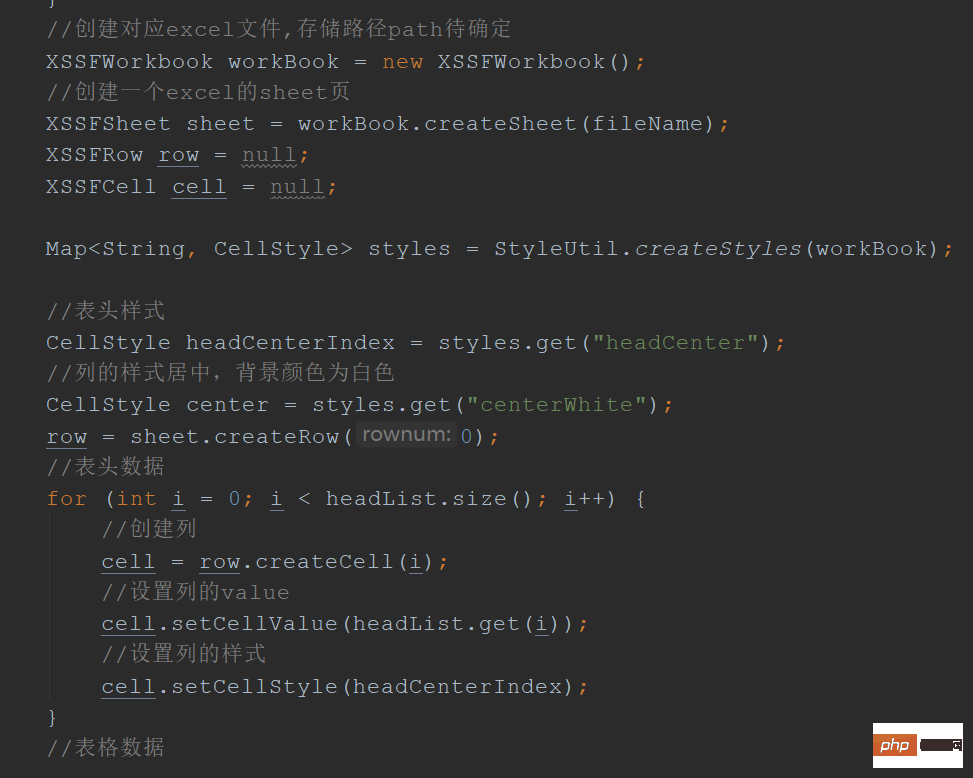Maison >Java >javaDidacticiel >Comment exporter des fichiers Excel en utilisant la méthode d'exportation en Java
Comment exporter des fichiers Excel en utilisant la méthode d'exportation en Java
- WBOYWBOYWBOYWBOYWBOYWBOYWBOYWBOYWBOYWBOYWBOYWBOYWBavant
- 2023-04-27 20:43:052195parcourir
1.fonction d'exportation
//导出文件接口
public String export(){
return this.myExport(exportList);
}2.Nom de la colonne d'exportation
private String myExport(List<BusinessDept> list){
com.bronzesoft.power.tools.json.JSONObject info = new com.bronzesoft.power.tools.json.JSONObject();
try{
List<String> headList = new ArrayList<String>(Arrays.asList("年", "月", "部门","部门负责人","经营值","收入", "支出","填报工时","标准工时","经营参数"));
Commonutil.export(list,headList,"部门经营总览导出");
info = Commonutil.setInfo(info,"部门经营总览导出");
}catch (Exception e){
LogUtil.error(this.getClass().getName()+".exportExcel()", e);
}
return info.toString();
}3.méthode de mise en œuvre de l'exportation
Tout d'abord, comprenez la forme organisationnelle d'un fichier Excel Un fichier Excel correspond à un classeur (XSSFWorkbook). have Il se compose de plusieurs feuilles (XSSFSheet), une feuille est composée de plusieurs lignes (XSSFRow) et une ligne est composée de plusieurs cellules (XSSFCell).

public static <T> boolean export(List<T> list,List<String> headList,String fileName){
return myExport(list,headList,fileName,com.bronzesoft.rdm.platform.util.Constants.PATH + com.bronzesoft.power.platform.Constants.TEMPFOLDER_DIR );
}
//将list导出为excel,文件名为fileName
public static <T> boolean myExport(List<T> list,List<String> headList,String fileName,String path){
try{
if(!checkListAndHead(list,headList)){
LogUtil.info( "head的长度有问题,导出的文件不正确" );
}
File file = new File(path + File.separator + fileName + ".xlsx");
if(!file.exists()) {
file.createNewFile();
}
//创建对应excel文件,存储路径path待确定
XSSFWorkbook workBook = new XSSFWorkbook();
//创建一个excel的sheet页
XSSFSheet sheet = workBook.createSheet(fileName);
XSSFRow row = null;
XSSFCell cell = null;
Map<String, CellStyle> styles = StyleUtil.createStyles(workBook);
//表头样式
CellStyle headCenterIndex = styles.get("headCenter");
//列的样式居中,背景颜色为白色
CellStyle center = styles.get("centerWhite");
row = sheet.createRow(0);
//表头数据
for (int i = 0; i < headList.size(); i++) {
//创建列
cell = row.createCell(i);
//设置列的value
cell.setCellValue(headList.get(i));
//设置列的样式
cell.setCellStyle(headCenterIndex);
}
//表格数据
//写入表格数据
String codeName = "";
int rownum = 1;
T obj = null;
for(int i = 0; i < list.size(); i++){
obj = list.get(i);
if(null != obj){
Field[] fields = obj.getClass().getDeclaredFields();
row = sheet.createRow(rownum);
for(int j = 0; j< fields.length; j++){
fields[j].setAccessible(true);
codeName = String.valueOf(fields[j].get(obj));
//创建第j列
cell = row.createCell(j);
cell.setCellValue(Commonutil.getStringVal(codeName));
cell.setCellStyle(center);
}
}
rownum++;
}
// //i代表列,设置列的宽度
// for (int i = 0; i < headList.size(); i++) {
// if(i == 0){
// sheet.setColumnWidth(i, 2000);
// }else if(i == 1 || i == 3){
// sheet.setColumnWidth(i, 6000);
// }else{
// sheet.setColumnWidth(i, 4000);
// }
// }
//将文件写到临时目录
FileOutputStream out = new FileOutputStream(file);
workBook.write(out);
}catch (Exception e){
LogUtil.error(fileName + "export失败" );
}
return true;
}
//检查head的size是否符合规范
public static <T> boolean checkListAndHead(List<T> list,List<String> headList){
if(list.size()>0){
T t = list.get(0);
if(getColumnCount(t) != headList.size()){
LogUtil.info( "head的长度有问题" );
return false;
}
}
return true;
}
//获取一个对象成员变量的个数
public static <T> int getColumnCount(T t){
Field[] fields = t.getClass().getDeclaredFields();
int count = fields.length;
return count;
}4. Docking frontal
public static JSONObject setInfo(JSONObject info,String fileName) throws Exception {
Storage s = Commonutil.getDefaultStorage();
info.put("port", String.valueOf(s.getPort()));
info.put("dirAddress", Base64Util.encode(com.bronzesoft.rdm.platform.util.Constants.PATH));
info.put("address", Base64Util.encode(com.bronzesoft.power.platform.Constants.TEMPFOLDER_DIR + File.separator + fileName + ".xlsx"));
info.put("name", Base64Util.encode(fileName));
info.put("extendName", "xlsx");
return info;
}5.
Ce qui précède est le contenu détaillé de. pour plus d'informations, suivez d'autres articles connexes sur le site Web de PHP en chinois!
Déclaration:
Cet article est reproduit dans:. en cas de violation, veuillez contacter admin@php.cn Supprimer

